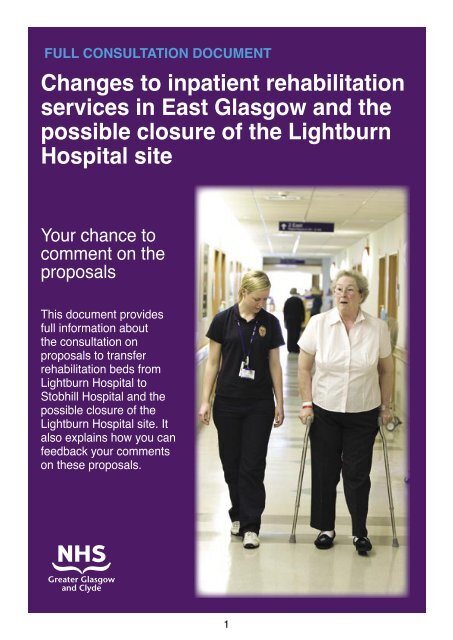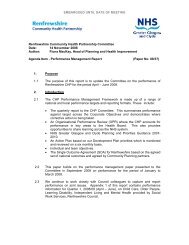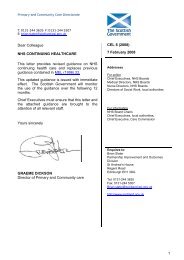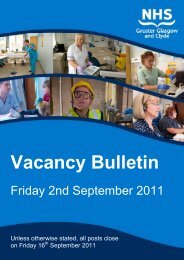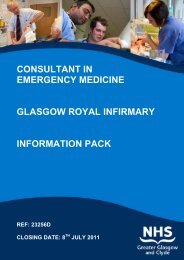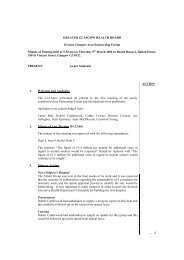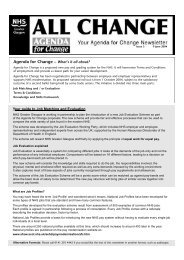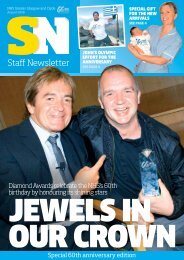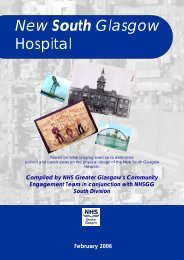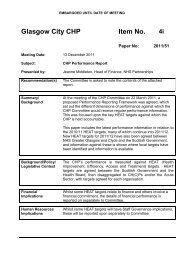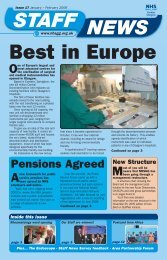Full - NHS Greater Glasgow and Clyde
Full - NHS Greater Glasgow and Clyde
Full - NHS Greater Glasgow and Clyde
Create successful ePaper yourself
Turn your PDF publications into a flip-book with our unique Google optimized e-Paper software.
FULL CONSULTATION DOCUMENT<br />
Changes to inpatient rehabilitation<br />
services in East <strong>Glasgow</strong> <strong>and</strong> the<br />
possible closure of the Lightburn<br />
Hospital site<br />
Your chance to<br />
comment on the<br />
proposals<br />
This document provides<br />
full information about<br />
the consultation on<br />
proposals to transfer<br />
rehabilitation beds from<br />
Lightburn Hospital to<br />
Stobhill Hospital <strong>and</strong> the<br />
possible closure of the<br />
Lightburn Hospital site. It<br />
also explains how you can<br />
feedback your comments<br />
on these proposals.<br />
1
1. Introduction<br />
1.1 The majority of older people live independently in the community, or with some support,<br />
<strong>and</strong> do not need to use hospital services at any time. However a small proportion of older<br />
people will require use of specialist services such as the Department for Medicine for the<br />
Elderly.<br />
1.2 In north <strong>and</strong> east <strong>Glasgow</strong> the Department for Medicine for the Elderly provides<br />
comprehensive multi-professional assessment <strong>and</strong> rehabilitation for people over 65 years<br />
within the following settings:<br />
• Inpatient Services - assessment <strong>and</strong> rehabilitation wards at three hospitals - <strong>Glasgow</strong><br />
Royal Infirmary, Stobhill Hospital <strong>and</strong> Lightburn Hospital<br />
• Outpatient Clinics – a range of consultant, nurse <strong>and</strong> Allied Health Profession (eg<br />
Physiotherapy, Occupational Therapy) led clinics at all three hospitals<br />
• Day hospital at Stobhill Hospital <strong>and</strong> Lightburn Hospital<br />
1.3 Lightburn Hospital has four wards (three wards for longer term inpatient rehabilitation, one<br />
ward which is not used for patient care); a day hospital; an outpatient clinic area; a WRVS<br />
café; <strong>and</strong> training <strong>and</strong> office areas for staff.<br />
1.4 In 2000, the long term strategy for acute services in <strong>Glasgow</strong> was the subject of public<br />
consultation <strong>and</strong> subsequently approved in 2002. This set out a long-term programme of<br />
hospital modernisation that would see high quality patient services provided through new<br />
ways of working in modern fit-for-purpose hospital buildings.<br />
1.5 The integration of acute inpatient services at Stobhill Hospital into <strong>Glasgow</strong> Royal<br />
Infirmary was a key part of this strategy, <strong>and</strong> in early 2011 all emergency, receiving <strong>and</strong><br />
acute assessment beds will move from Stobhill Hospital into refurbished facilities at<br />
<strong>Glasgow</strong> Royal Infirmary. For people in north <strong>and</strong> east <strong>Glasgow</strong> requiring Department for<br />
Medicine for the Elderly inpatient assessment, it will mean all patients will be admitted into<br />
Department for Medicine for the Elderly assessment wards at <strong>Glasgow</strong> Royal Infirmary<br />
providing excellent on-site access to a wide range of other medical specialties, diagnostic<br />
investigations <strong>and</strong> specialist care.<br />
1.6 In October 2008 the Board approved the building of 60 new beds at New Stobhill Hospital.<br />
48 of these beds were designated for elderly rehabilitation to significantly improve<br />
accommodation for this specialist area of service.<br />
1.7 The current redesign of Department for Medicine for the Elderly services in north <strong>and</strong> east<br />
<strong>Glasgow</strong> is part of this same overall Acute Services Review programme.<br />
2. Purpose of Consultation Document<br />
2.1 <strong>NHS</strong> <strong>Greater</strong> <strong>Glasgow</strong> <strong>and</strong> <strong>Clyde</strong> has considered a number of options for the delivery of<br />
Department for Medicine for the Elderly inpatient rehabilitation services in north <strong>and</strong> east<br />
<strong>Glasgow</strong>. These options are:<br />
Option 1:<br />
Service provision over three sites – <strong>Glasgow</strong> Royal Infirmary, Stobhill<br />
Hospital <strong>and</strong> Lightburn Hospital<br />
Under this option all assessment beds are at <strong>Glasgow</strong> Royal Infirmary. Longer term<br />
rehabilitation beds would be split between Stobhill Hospital <strong>and</strong> Lightburn Hospital. At<br />
Stobhill this would be the beds within New Stobhill Hospital . At Lightburn this would be<br />
within two refurbished wards.<br />
2
Option 2:<br />
Service provision over two sites – <strong>Glasgow</strong> Royal Infirmary <strong>and</strong> Stobhill<br />
Hospital<br />
Under this option all assessment beds are at <strong>Glasgow</strong> Royal Infirmary. Longer term<br />
rehabilitation beds would be provided on one single site at Stobhill Hospital. Provision<br />
would be the beds within New Stobhill Hospital <strong>and</strong> further beds within the existing<br />
refurbished rehabilitation wards. Under this option all beds at Lightburn Hospital would be<br />
closed.<br />
Option 3:<br />
Service provision over two sites – <strong>Glasgow</strong> Royal Infirmary <strong>and</strong><br />
Lightburn Hospital<br />
Under this option all assessment beds are at <strong>Glasgow</strong> Royal Infirmary. Longer term<br />
rehabilitation would be provided on one single site at Lightburn Hospital. Provision would<br />
be within existing wards. Under this option the 48 new purpose-built beds at New Stobhill<br />
Hospital would remain vacant as no other specialty requires this type of accommodation at<br />
the hospital.<br />
2.2 <strong>NHS</strong> <strong>Greater</strong> <strong>Glasgow</strong> <strong>and</strong> <strong>Clyde</strong> is now consulting on its preferred option – Option 2, the<br />
transfer of rehabilitation beds to Stobhill Hospital <strong>and</strong> possible closure of the Lightburn<br />
Hospital.<br />
2.3 There are no current plans to locate new clinical services onto the Lightburn Hospital site.<br />
Therefore if all other services <strong>and</strong> staff at Lightburn Hospital are able to be relocated the<br />
site will be surplus to requirements <strong>and</strong> the <strong>NHS</strong> board will seek consent for its closure <strong>and</strong><br />
disposal.<br />
2.4 This document provides more detail about these options <strong>and</strong> describes:<br />
• Redesigning Department for Medicine for the Elderly Inpatient Services in north <strong>and</strong> east<br />
<strong>Glasgow</strong> – section 3<br />
• Reviewing the location of rehabilitation beds – drivers for change – section 4<br />
• Involvement <strong>and</strong> engagement process – section 5<br />
• Options for service change – section 6<br />
• Finance – section 7<br />
• Preferred option – section 8<br />
• Impact on patients – section 9<br />
• Workforce implications – section 10<br />
• Public consultation process – section 11<br />
• What happens next – section 12<br />
3. Redesigning Department for Medicine for the Elderly Inpatient Services in north <strong>and</strong><br />
east <strong>Glasgow</strong><br />
3.1 The East <strong>and</strong> North <strong>Glasgow</strong> Community Health <strong>and</strong> Care Partnerships have populations<br />
with large concentrations of poverty <strong>and</strong> disadvantage.<br />
3.2 Whilst across Scotl<strong>and</strong> by 2016 the over 65 year population is expected to increase by<br />
approximately 9% in north <strong>and</strong> east <strong>Glasgow</strong> the trend is expected to be different with an<br />
overall reduction in the over 65 year population by 2016 (see table 1 below).<br />
3
Table 1: Population of people over 65 yrs in north <strong>and</strong> east <strong>Glasgow</strong><br />
CHCP 2006 2016 % change<br />
North 14,582 13,979 4% decrease<br />
East 19,612 19,511 0.5% decrease<br />
3.3 As outlined at 1.2 the Department for Medicine for the Elderly provides comprehensive<br />
assessment <strong>and</strong> rehabilitation for people over 65 years of age. Typically older people<br />
are not admitted directly from home to a Department for Medicine for the Elderly ward,<br />
but are transferred from another inpatient ward area (eg general medicine, orthopaedics)<br />
when their needs are felt to indicate a period of assessment <strong>and</strong> rehabilitation would be<br />
beneficial.<br />
3.4 People admitted to a Department for Medicine for the Elderly assessment ward undergo<br />
assessment from a multi-professional team including doctors, nursing staff <strong>and</strong> allied health<br />
professionals (eg physiotherapists, occupational therapists). This assessment involves a<br />
range of investigations, nursing care <strong>and</strong> rehabilitation approaches. In 2009/10 there were<br />
approximately 3000 discharges/transfers from the Department for Medicine for the Elderly<br />
assessment wards in north <strong>and</strong> east <strong>Glasgow</strong>, with the average length of stay 10-14 days.<br />
3.5 A number of people are not fit to be discharged at this point <strong>and</strong> require a longer period of<br />
rehabilitation in hospital. These people will be transferred to a Department for Medicine for<br />
the Elderly rehabilitation ward for further rehabilitation before being ready for discharge. In<br />
the last year approximately 520 people were discharged from the rehabilitation wards at<br />
Lightburn Hospital <strong>and</strong> 650 people were discharged from the rehabilitation wards at Stobhill<br />
Hospital. Our data shows that for approximately 20% of these patients their length of stay<br />
in a rehabilitation ward was less than two weeks, however for 10% of these patients it was<br />
in excess of three months. The average length of stay in a rehabilitation ward is five-six<br />
weeks.<br />
3.6 Integrating assessment beds onto one single site for north <strong>and</strong> east <strong>Glasgow</strong> (see 1.5)<br />
provides the service with significant opportunity to develop new ways of working that will<br />
deliver the following benefits for patients:<br />
• A stronger focus on early rehabilitation<br />
• People will be fitter for discharge earlier allowing a reduced time in hospital<br />
• Less interruption to a patient’s rehabilitation from transferring between wards<br />
3.7 Recent work in <strong>NHS</strong> <strong>Greater</strong> <strong>Glasgow</strong> <strong>and</strong> <strong>Clyde</strong> has shown that adopting new ways of<br />
working can have a positive impact on reducing length of stay in hospital. This includes<br />
changes to the timing <strong>and</strong> frequency of consultant ward rounds; extending pilot work around<br />
physiotherapy staff working at weekends; intensified discharge planning <strong>and</strong> goal setting<br />
during rehabilitation, <strong>and</strong> is in addition to continuing current multi-agency work on reducing<br />
delays in discharge from hospital<br />
3.8 This will lead to a rebalancing between rehabilitation beds <strong>and</strong> assessment beds. The<br />
overall number of beds will remain consistent but the balance will change<br />
2010 2011 % change Actual bed no.<br />
change<br />
DME assessment beds 156 185 Increase of 18% +29<br />
DME rehabilitation 135 106 Decrease of -29<br />
beds<br />
21%<br />
TOTAL 291 291 No change 0<br />
3.9 The service recognises the importance of having the best possible assessment <strong>and</strong><br />
4
ehabilitation elements to the inpatient service. The change to assessment beds has<br />
therefore given the opportunity to review the location of rehabilitation beds in north <strong>and</strong> east<br />
<strong>Glasgow</strong>.<br />
4. Reviewing the Location of Rehabilitation Beds – Drivers for Change<br />
4.1 The 135 rehabilitation beds are located at Lightburn Hospital (75 beds) <strong>and</strong> Stobhill Hospital<br />
(60 beds). In 2011 this will reduce to 106 beds to accommodate the increase in assessment<br />
beds.<br />
4.2 The following factors have been taken into account in the review of rehabilitation beds in<br />
addition to national <strong>and</strong> local policy direction:<br />
• A need to deliver high st<strong>and</strong>ards of care to all Department for Medicine for the Elderly<br />
patients, both inpatients <strong>and</strong> outpatients<br />
• A need to deliver improved Department for Medicine for the Elderly ward facilities<br />
• A need to deliver cost savings that support the overall delivery of the Acute Services<br />
Review<br />
4.3 There are a number of clinical issues that impact on patient care associated with delivering<br />
this element of the service across two hospital sites:<br />
• Maintaining Effective Cover Across All Inpatient Sites:<br />
Each hospital site has doctors in training working there during the day <strong>and</strong> providing an<br />
on-call service in the evenings <strong>and</strong> at weekends. Following changes to the way doctors<br />
are trained there are now fewer doctors available to cover all the required duties, <strong>and</strong> in<br />
addition the introduction of European Working Time Directives reduces the total number<br />
of hours that a doctor can work each week. This means that if the number of sites<br />
covered by doctors can be reduced, it increases the overall amount of time that doctors<br />
can spend on the wards enabling faster access to medical care <strong>and</strong> thus improving<br />
overall quality of clinical care.<br />
Some specialist Allied Health Professional staff, such as those in stroke rehabilitation,<br />
also work across both sites <strong>and</strong> a single site would allow increased flexibility in staffing<br />
<strong>and</strong> reduce time spent in travel, thereby giving patients better access to treatment.<br />
• Access to Diagnostic Investigations:<br />
The New Stobhill Hospital provides modern diagnostic facilities in a new fit-for-purpose<br />
building, including X-ray, CT scanner, MRI scanner <strong>and</strong> ultrasound as well as a<br />
cardiology department, a respiratory department <strong>and</strong> an endoscopy unit. All inpatient<br />
areas on the Stobhill site have ready access to these diagnostic facilities, <strong>and</strong> in addition<br />
the new inpatient beds currently being built at New Stobhill Hospital (see 1.6) are<br />
adjacent to all the new hospital’s diagnostic <strong>and</strong> therapy facilities.<br />
Lightburn Hospital has part-time X-ray facilities which are in need of upgrade to maintain<br />
the equipment to current st<strong>and</strong>ards. There are limited cardiology investigations<br />
available on site, but no access to CT or endoscopy. Patients in rehabilitation wards<br />
may still require investigations during their stay in hospital that are not available at<br />
Lightburn. In 2009/10 there were 567 journeys taking patients from Lightburn to<br />
<strong>Glasgow</strong> Royal Infirmary to access other diagnostic facilities. This journey means the<br />
patient is away from the ward with the subsequent impact on their rehabilitation. There<br />
is also a reduction in the ward nurse staffing levels as each patient requires an escort for<br />
the journey.<br />
• Quality of Accommodation:<br />
Existing rehabilitation wards at both Stobhill Hospital <strong>and</strong> Lightburn Hospital are in need<br />
5
of refurbishment to bring them up to expected st<strong>and</strong>ards in terms of number of<br />
single rooms <strong>and</strong> overall space <strong>and</strong> facilities. Both hospitals have access to therapy<br />
areas adjacent to the wards.<br />
In early 2011, 48 rehabilitation beds will become available in the new purpose-built<br />
accommodation at New Stobhill Hospital. This will have 24 single rooms with en-suite<br />
facilities <strong>and</strong> six four-bedded rooms each with a shower <strong>and</strong> toilet. There will be areas<br />
for therapy <strong>and</strong> in addition ready access to the therapy <strong>and</strong> diagnostic facilities at New<br />
Stobhill Hospital..<br />
• Impact on the Wider Hospital Site:<br />
The existing rehabilitation wards at Stobhill Hospital are only a small part of the<br />
overall site located away from the acute facilities to be vacated in early 2011, <strong>and</strong><br />
any change to the wards would have minimal impact on the rest of the hospital site.<br />
Additional Department for Medicine for the Elderly services at Stobhill Hospital include<br />
day hospital <strong>and</strong> outpatient clinics. In the last year 532 new patients attended Stobhill<br />
day hospital, <strong>and</strong> each week there were approximately 10 consultant or nurse/AHP-led<br />
outpatient clinics.<br />
As noted at 1.3 Lightburn Hospital is a small hospital site. In addition to the ward areas<br />
at Lightburn, Department for Medicine for the Elderly services also include a day<br />
hospital <strong>and</strong> outpatient clinics. In the last year 371 new patients attended Lightburn<br />
day hospital, <strong>and</strong> each week there were approximately 10 consultant or nurse/AHP-led<br />
outpatient clinics. Any change that removed the inpatient wards at Lightburn Hospital<br />
would have a significant impact on the rest of the hospital site giving two potential<br />
options for the Board to consider:<br />
Ø Relocating outpatient <strong>and</strong> day hospital activity, <strong>and</strong> identifying alternative office <strong>and</strong><br />
training accommodation enabling closure of the hospital site; or<br />
Ø Identifying other services that could make use of the ward areas, for example as<br />
refurbished office accommodation, <strong>and</strong> maintaining the site for day hospital <strong>and</strong><br />
outpatient activity<br />
5. Involvement <strong>and</strong> Engagement Processes<br />
5.1 In February 2010 the Scottish Government issued guidance on Informing, Engaging <strong>and</strong><br />
Consulting People in Developing Health <strong>and</strong> Community Care Services. The guidance<br />
aims to ensure a consistent <strong>and</strong> robust approach is adopted when Boards consider <strong>and</strong><br />
propose new services or changes to existing services.<br />
5.2 The <strong>NHS</strong> <strong>Greater</strong> <strong>Glasgow</strong> <strong>and</strong> <strong>Clyde</strong> Community Engagement Team <strong>and</strong> managers<br />
from the Rehabilitation <strong>and</strong> Assessment Directorate have worked with the Scottish Health<br />
Council to develop a process that facilitates the participation of a range of non-clinical<br />
stakeholders in the discussions concerning the future location of rehabilitation beds in north<br />
<strong>and</strong> east <strong>Glasgow</strong>.<br />
5.3 The programme of engagement has sought to:<br />
• Build relationships with interested groups<br />
• Ensure that all aspects of engagement are conducted in an inclusive, sensitive <strong>and</strong><br />
values-based manner<br />
• Ensure that patient <strong>and</strong> carer input is considered in all aspects of the review<br />
• Ensure that all specific impacts of engagement are conducted in an open, inclusive,<br />
sensitive <strong>and</strong> value-based manner<br />
5.4 This work has been carried out between June <strong>and</strong> August 2010. The work commenced in<br />
6
June with a general overview presentation to the Acute Operating<br />
Panel. The programme of engagement also included:<br />
• A presentation to the East <strong>Glasgow</strong> CHCP Public Partnership Forum<br />
Division’s Patients’<br />
• Twenty-Three one-to-one semi-structured interviews with patients from inpatients,<br />
outpatients <strong>and</strong> Day Hospital at Lightburn Hospital exploring their experience in hospital<br />
<strong>and</strong> their views on the location of their treatment <strong>and</strong> rehabilitation<br />
• Two focus groups – one for local patients <strong>and</strong> carers (10 attendees) <strong>and</strong> one for<br />
representatives from local community organisations/groups (nine attendees). The focus<br />
groups aimed to:<br />
Ø Provide information on the issues <strong>and</strong> possible changes to the location of<br />
rehabilitation beds in north <strong>and</strong> east <strong>Glasgow</strong><br />
Ø Offer opportunity for discussion <strong>and</strong> clarification<br />
Ø Develop possible options for the future location of rehabilitation beds; <strong>and</strong><br />
Ø Agree criteria that are relevant <strong>and</strong> important to patients <strong>and</strong> carers in measuring the<br />
options<br />
• An option appraisal exercise involving members of the focus groups, a small number<br />
of selected staff from Lightburn Hospital <strong>and</strong> Unison staff representatives (in total<br />
27 attendees). This exercise appraised the options developed in the focus groups <strong>and</strong><br />
outlined the next steps in the review of the location of rehabilitation beds <strong>and</strong> associated<br />
engagement programme<br />
5.5 The government guidance has been carefully followed at each stage of the engagement<br />
process. The guidance is clear in stating that patients, carers <strong>and</strong> the public can play an<br />
important role in the assessment of non-financial costs <strong>and</strong> benefits in options for service<br />
change. It advises that financial issues should be considered separately from the nonfinancial<br />
benefits of any service change. As such whilst the need to provide cost effective<br />
services was highlighted to focus group participants, it was not until the option appraisal<br />
process was completed that participants were briefed on the Board financial position <strong>and</strong><br />
the potential costs <strong>and</strong> savings from elements of each of the options.<br />
6. Options for Service Change<br />
6.1 This section explains the options that have been considered during the pre-engagement<br />
phase of this work.<br />
6.2 The interviews with patients outlined at 5.4 explored their general experiences of Lightburn<br />
Hospital <strong>and</strong> their thoughts on receiving their care from a different location (hospital site).<br />
The opinions gathered from these interviews provide valuable information for consideration.<br />
6.3 There were a number of common themes arising from the interviews:<br />
• Patients clearly valued the service they were receiving<br />
• Staff were praised for their care, friendliness <strong>and</strong> attention<br />
• Most inpatients were not concerned where they were transferred for rehabilitation as long<br />
as the care was good<br />
• Most inpatients were concerned for their visitor’s ability to access the hospital if they<br />
were at a different hospital site. This comment was not dependent on whether their<br />
visitors used a car or public transport<br />
• People attending outpatients or day hospital showed less concern about the location of<br />
their appointment as long as transport continued to be provided<br />
7
6.4 Work with the focus groups outlined at 5.4 identified both a long list <strong>and</strong> short list of options<br />
for the future location of rehabilitation beds. These options were similar to those explored<br />
by the clinical management team within Department for Medicine for the Elderly services.<br />
The following three options were short listed:<br />
Option 1:<br />
Service provision over three sites – <strong>Glasgow</strong> Royal Infirmary, Stobhill<br />
Hospital <strong>and</strong> Lightburn Hospital<br />
Under this option all assessment beds are at <strong>Glasgow</strong> Royal Infirmary. Longer term<br />
rehabilitation beds would be split between Stobhill Hospital <strong>and</strong> Lightburn Hospital. At<br />
Stobhill this would be the beds within New Stobhill Hospital. At Lightburn this would be<br />
within two refurbished wards.<br />
Option 2:<br />
Service provision over two sites – <strong>Glasgow</strong> Royal Infirmary <strong>and</strong> Stobhill<br />
Hospital<br />
Under this option all assessment beds are at <strong>Glasgow</strong> Royal Infirmary. Longer term<br />
rehabilitation beds would be provided on one single site at Stobhill Hospital. Provision<br />
would be the beds within New Stobhill Hospital, <strong>and</strong> further beds within the refurbished<br />
existing rehabilitation wards. Under this option all beds at Lightburn Hospital would be<br />
closed.<br />
Option 3:<br />
Service provision over two sites – <strong>Glasgow</strong> Royal Infirmary <strong>and</strong><br />
Lightburn Hospital<br />
Under this option all assessment beds are at <strong>Glasgow</strong> Royal Infirmary. Longer term<br />
rehabilitation would be provided on one single site at Lightburn Hospital. Provision would<br />
be within existing wards. Under this option the 48 new purpose-built beds at New Stobhill<br />
Hospital would remain vacant as no other specialty requires this type of accommodation at<br />
the hospital.<br />
6.5 Discussions with the patients <strong>and</strong> focus groups identified the following criteria to assess<br />
these options:<br />
• Quality of Patient Accommodation (ward accommodation should be clean, provide<br />
appropriate space <strong>and</strong> toilet facilities, <strong>and</strong> have access to natural light)<br />
• Transport for visitors (availability of public transport <strong>and</strong> car parking, <strong>and</strong> timing of ward<br />
visiting times)<br />
• Discharge Planning (multi-agency, carer or family involvement, timeliness)<br />
• Quality of care (person-centred, friendly, respectful, involving)<br />
These were incorporated with the objectives of the redesign:<br />
• Improve access to required diagnostics<br />
• Deliver cost savings/efficiencies<br />
• Reduce number of sites to two<br />
Although ‘saving money’ was acknowledged as an important factor, in line with guidance<br />
(see 5.5) financial aspects were not included in the scoring process for each of the options.<br />
6.6 As well as these clear criteria, the discussions drew out further valuable opinion to consider.<br />
Key points raised from the discussions with patients <strong>and</strong> the focus groups were:<br />
• Concern that the decision has already been made to close Lightburn Hospital<br />
• Need to ensure community provision is in place on discharge from hospital; early multiagency<br />
planning for discharge from hospital needs to be improved <strong>and</strong> family <strong>and</strong> carers<br />
need to be more involved.<br />
• Transport within <strong>and</strong> from the East End of <strong>Glasgow</strong> is poor<br />
8
• Visitors provide a helpful role in supporting people’s mental health <strong>and</strong> overall recovery<br />
whilst in hospital, so access for visitors is an important factor<br />
6.6.1 A number of general access <strong>and</strong> transport issues was raised by patients, carers groups <strong>and</strong><br />
community group representatives. These include:<br />
• The experience of patient transport could be improved by better time planning <strong>and</strong><br />
communication with the patients<br />
• The " East of <strong>Glasgow</strong>" is a large area <strong>and</strong> some areas are not readily accessible to<br />
residents - it can take two buses to reach the <strong>Glasgow</strong> Royal Infirmary or Lightburn from<br />
parts of East <strong>Glasgow</strong><br />
• Stobhill is perceived as being difficult to reach - it can also take two buses to get to<br />
Stobhill<br />
• All patient transport for inpatients is provided by the Scottish Ambulance Service (SAS)<br />
• A majority of transport for day hospitals <strong>and</strong> outpatients is provided by the SAS, a<br />
minority is provided by relatives or carers who come from a wide area to provide this<br />
transport<br />
• Good or easy to use transport was a concern for many who perceived it as being<br />
important in supporting carers or relatives to visit their loved ones whilst in hospital<br />
• Community groups were aware of the Evening Visitor Transport Service <strong>and</strong> rated it<br />
highly, but patients were not aware of it<br />
6.7 The option appraisal exercise was undertaken with the three groups – carers, community<br />
representatives <strong>and</strong> staff – each separately agreeing on weighted values for each of the<br />
criteria, <strong>and</strong> then each individual within the group scoring each of the three options against<br />
the criteria.<br />
6.8 This was only the second time this form of option appraisal has been undertaken within<br />
<strong>NHS</strong> <strong>Greater</strong> <strong>Glasgow</strong> <strong>and</strong> <strong>Clyde</strong> since the new guidance was issued in February 2010.<br />
The process has been helpful to take people through the issues <strong>and</strong> participants appear to<br />
have appreciated the opportunity to underst<strong>and</strong> <strong>and</strong> discuss the options. However it has<br />
been clear that there were issues in undertaking the technical part of the option appraisal.<br />
<strong>NHS</strong>GGC has committed to provide the Scottish Health Council (SHC) with their feedback<br />
about the process, <strong>and</strong> the SHC has undertaken their own evaluation with participants the<br />
results of which will be shared with the Board.<br />
6.9 The results of the option appraisal (Appendix 1) show quite a varied response, re-enforcing<br />
the complexity of what people had been asked to participate in, <strong>and</strong> in some cases, fixed<br />
viewpoints of individuals.<br />
6.10 Analysis of the option appraisal showed no single common favoured option across the three<br />
groups. The carers group favoured option 1, the community representatives favoured option<br />
2 <strong>and</strong> the staff group favoured option 3. When results across all groups were collated,<br />
options 1 <strong>and</strong> 2 are the favoured options.<br />
Patient/<br />
Carers<br />
Option 1 Option 2 Option 3<br />
Basic Weighted Basic Weighted Basic Weighted<br />
Total 316 5330 293 4990 302 4960<br />
Median 34 560 30 520 36 565<br />
Mean 35.1 592.2 32.6 554.4 33.6 551.1<br />
9
Community Option 1 Option 2 Option 3<br />
Basic Weighted Basic Weighted Basic Weighted<br />
Total 304 5591 329 5908 278 4915<br />
Median 38.5 719 37.5 674 33 573.5<br />
Mean 38 698.9 41.1 738.5 34.8 614.4<br />
Staff Option 1 Option 2 Option 3<br />
Basic Weighted Basic Weighted Basic Weighted<br />
Total 248 4955 272 4945 263 4978<br />
Median 30.5 632 36 660.5 32 614<br />
Mean 31 619.4 34.0 618.1 32.9 622.3<br />
Collated<br />
Weighted<br />
Results Option 1 Option 2 Option 3<br />
Total 15876 15843 14853<br />
Median<br />
Mean<br />
657<br />
635.0<br />
657<br />
633.7<br />
590<br />
594.1<br />
7. Finance<br />
7.1 Each of the options provides a similar ward configuration <strong>and</strong> therefore nurse <strong>and</strong> other<br />
staffing levels <strong>and</strong> costs would be similar under each of the options. In addition, current<br />
medical <strong>and</strong> Allied Health Professional staffing levels <strong>and</strong> costs will be retained under each<br />
of these proposals.<br />
7.2 The costs of upgrading existing rehabilitation wards in each of the options are outlined<br />
below. In order to meet bed spacing <strong>and</strong> provide 50% single rooms the current 30 bed<br />
wards would only accommodate 26 beds at Stobhill <strong>and</strong> 24 beds at Lightburn.<br />
Ward<br />
refurbishment<br />
costs<br />
Lightburn X-ray<br />
upgrade costs<br />
Option 1 Option 2 Option 3<br />
2 wards at 2 wards at Stobhill 4 wards at Lightburn<br />
Lightburn £1.15m per ward £1.3 m per ward<br />
£1.3m per ward 2 bed shortfall 10 bed shortfall<br />
10 bed shortfall<br />
£300k N/A £300k<br />
7.3 It is important to note that the new build rehabilitation unit with 24 single rooms with en-suite<br />
facilities at Stobhill Hospital forms part of the contract for this hospital <strong>and</strong> will still incur<br />
spend of £1.3m even if lying vacant (Option 3).<br />
7.4 If all services <strong>and</strong> staff are moved off the Lightburn Hospital site, <strong>and</strong> the site closed, this<br />
could generate savings in the region of £500k. The exact figure would depend on the<br />
locations identified for outpatient <strong>and</strong> day hospital services. The subsequent sale of the site<br />
could also generate a capital receipt.<br />
8. Preferred Option<br />
8.1 This section explains our preferred option <strong>and</strong> why we consider this to be the best option.<br />
10
We invite stakeholders, as part of this consultation, to comment on our proposal, our<br />
conclusions on the other options, <strong>and</strong> whether they consider that there are other viable<br />
options we have not considered. These comments will be reported to the Board before it<br />
reaches its decision.<br />
8.2 In recommending a preferred option the following issues have been considered...<br />
• The option appraisal process involving staff, patients/carers <strong>and</strong> other community<br />
stakeholders did not produce a clear preferred option.<br />
• It is not practical or cost-effective to leave the newly built beds at Stobhill vacant which<br />
therefore removes Option 3 from consideration<br />
• There are clinical benefits to locating all rehabilitation beds on a single site<br />
• There is a potential cost saving to the Board if all services can be relocated from<br />
Lightburn. It is likely that the non-inpatient services can be accommodated within existing<br />
<strong>NHS</strong> sites at minimal cost whilst maintaining local access.<br />
• There are transport issues with all hospital sites <strong>and</strong> most patients use hospital or<br />
relatives transport. A transport needs assessment will be undertaken. There is capacity<br />
within the Evening Transport Visitor Service which is available for visitors without their<br />
own transport <strong>and</strong> an awareness raising campaign of this in the local communities will be<br />
undertaken<br />
8.3 It is therefore recommended that, in view of the savings generated, the preferred option for<br />
the Board is to:<br />
• Locate all rehabilitation beds at Stobhill Hospital ie move 75 beds from Lightburn<br />
• Seek to identify alternative locations for outpatient <strong>and</strong> day hospital services<br />
9. Impact on patients<br />
9.1 Our underst<strong>and</strong>ing of the patient journey shows us the majority of patients will be<br />
discharged from their assessment ward directly home without requiring a longer period of<br />
rehabilitation in hospital. This will mean for most people there will be no change from these<br />
proposals as their inpatient care will continue to be at <strong>Glasgow</strong> Royal Infirmary.<br />
9.2 However for around 450 patients per year who require longer term rehabilitation in hospital,<br />
this would be within Stobhill Hospital rather than Lightburn Hospital.<br />
9.3 The accommodation for people in rehabilitation wards will be improved <strong>and</strong> will bring all<br />
patients nearer to diagnostic facilities such as MRI scanner, CT scanner <strong>and</strong> ultrasound.<br />
9.4 It is likely that most of the outpatient <strong>and</strong> day hospital services at Lightburn Hospital can be<br />
accommodated within the local community. Further work is being taken forward during the<br />
public consultation period to identify appropriate facilities.<br />
10. Workforce Implications<br />
10.1 There are currently 118 staff working within the wards at Lightburn <strong>and</strong> 40 domestic,<br />
catering <strong>and</strong> portering staff on site. There are 11 staff employed within the day hospital <strong>and</strong><br />
37 other staff located in offices on the site.<br />
10.2 Key staff organisations have been involved in the development of this work to date <strong>and</strong><br />
will continue to be involved as this work progresses. The full implications for all staff<br />
will be discussed with them individually <strong>and</strong> will include partnership <strong>and</strong> professional<br />
representatives. The Organisational Change Policy will apply <strong>and</strong> the overarching principle<br />
in managing change will be security of employment for existing staff.<br />
11
11. Public Consultation Process<br />
11.1 Public consultation about our proposals was launched on Monday 30 th August 2010 <strong>and</strong> is<br />
due to end on Tuesday 30 th November 2010.<br />
11.2 A leaflet summarising the proposals <strong>and</strong> the information contained within this document has<br />
been widely distributed. If you would like a copy of this you can either download it directly<br />
from our website at www.nhsggc.org.uk/elderlyrehab or you can call 0800 027 7246<br />
during normal working hours for a copy to be posted out to you.<br />
11.3 If you would like copies of this document, or the summary leaflet, in alternative formats such<br />
as audio tape, British sign language or Braille or would like translations of the documents<br />
into languages other than English, please call 0800 027 7246.<br />
11.4 <strong>NHS</strong> <strong>Greater</strong> <strong>Glasgow</strong> <strong>and</strong> <strong>Clyde</strong> will host a number of public events during the consultation<br />
period. Public meetings will be allocated on a first come, first served basis. If you wish to attend<br />
one of the public meetings please register on 0800 027 7246.<br />
Public meetings<br />
Monday 18th October 2010<br />
2.00pm - 4.00pm<br />
Eastbank Health Promotion Centre<br />
22 Academy Street<br />
<strong>Glasgow</strong> G32 9AA<br />
Thursday 21st October 2010<br />
6.30pm – 8.30pm<br />
John Wheatley College<br />
East End Campus<br />
2 Haghill Road<br />
<strong>Glasgow</strong> G31 3SR<br />
11.5 We will also host a number of drop-in sessions to enable service users <strong>and</strong> the public to<br />
obtain more information or submit points of view. If you wish to find out more about the drop-in<br />
sessions, please contact 0141 201 5598 or email community.engagement@ggc.scot.nhs.uk<br />
11.6 Staff meetings <strong>and</strong> briefings are also being organised <strong>and</strong> staff will be notified of these<br />
directly.<br />
11.7 Comments on all aspects of our proposals are welcome by 30 th November 2010. You<br />
can:<br />
Write to:<br />
Rehabilitation Services in East <strong>Glasgow</strong><br />
c/o Shirley Gordon<br />
Secretariat Manager<br />
<strong>NHS</strong> <strong>Greater</strong> <strong>Glasgow</strong> & <strong>Clyde</strong> Corporate Headquarters<br />
JB Russell House<br />
Gartnavel Royal Hospital<br />
1055 Great Western Road<br />
<strong>Glasgow</strong><br />
G12 0XH<br />
Or Visit our website at www.nhsggc.org.uk/elderlyrehab where you will be able to make<br />
an email submission.<br />
12
CONSULTATION SUBMISSIONS MUST BE RECEIVED NO LATER THAN TUESDAY 30 th<br />
NOVEMBER 2010.<br />
12. What happens next<br />
Once we have received comments from all interested parties, we will carefully review all we<br />
have been told. Our aim is to take a final proposal to the <strong>NHS</strong> <strong>Greater</strong> <strong>Glasgow</strong> & <strong>Clyde</strong><br />
Board on 21 st December 2010. The proposal will contain details of the public consultation<br />
process <strong>and</strong> a full summary or all comments received during the consultation period. If<br />
approval is given, our recommendation will then be forwarded to the Cabinet Secretary for<br />
Health <strong>and</strong> Wellbeing. The Cabinet Secretary will make the final decision as to whether the<br />
proposal goes ahead or not.<br />
This outcome will then be communicated by mail <strong>and</strong> email to all people <strong>and</strong> organisations<br />
taking part in the consultation.<br />
13
Appendix 1<br />
Patient/Carers Option 1 Option 2 Option 3<br />
Participant Basic Weighted Basic Weighted Basic Weighted<br />
1 29 450 30 425 21 325<br />
2 28 535 48 805 37 565<br />
3 32 510 30 470 36 620<br />
4 41 705 34 600 36 640<br />
5 44 735 27 520 48 805<br />
6 44 685 27 455 33 450<br />
7 43 755 35 645 37 655<br />
8 34 560 27 510 24 450<br />
9 21 395 35 560 30 450<br />
10 N/R N/R N/R N/R N/R N/R<br />
Total 316 5330 293 4990 302 4960<br />
Median 34 560 30 520 36 565<br />
Mean 35.1 592.2 32.6 554.4 33.6 551.1<br />
Community Option 1 Option 2 Option 3<br />
Participant Basic Weighted Basic Weighted Basic Weighted<br />
1 45 845 36 630 31 555<br />
2 37 706 34 663 34 660<br />
3 40 773 45 823 44 788<br />
4 43 732 37 673 45 758<br />
5 25 443 36 675 26 455<br />
6 37 654 38 657 32 557<br />
7 35 650 51 887 30 552<br />
8 42 788 52 900 36 590<br />
Total 304 5591 329 5908 278 4915<br />
Median 38.5 719 37.5 674 33 573.5<br />
Mean 38 698.9 41.1 738.5 34.8 614.4<br />
Staff Option 1 Option 2 Option 3<br />
Participant Basic Weighted Basic Weighted Basic Weighted<br />
1 32 607 37 691 38 713<br />
2 30 667 38 694 39 721<br />
3 35 657 20 452 27 538<br />
4 31 440 29 506 27 475<br />
5 30 667 38 694 39 721<br />
6 28 568 35 587 32 582<br />
7 26 565 40 664 32 621<br />
8 36 784 35 657 29 607<br />
9 N/R N/R N/R N/R N/R N/R<br />
Total 248 4955 272 4945 263 4978<br />
Median 30.5 632 36 660.5 32 614<br />
Mean 31 619.4 34.0 618.1 32.9 622.3<br />
14
Appendix 2<br />
Glossary of Terms/Abbreviations<br />
Acute Services Review A review undertaken by <strong>NHS</strong> <strong>Greater</strong> <strong>Glasgow</strong> in 2000<br />
– 2002 looking at the future of hospitals in <strong>Glasgow</strong><br />
CT Scanner<br />
Computerised Tomography Scanner, a special type of X-ray machine<br />
Endoscopy<br />
A medical procedure to examine inside the body<br />
Inpatient<br />
People who need to be cared for overnight or longer in a hospital bed<br />
Mean<br />
The average value of a set of numbers.<br />
Median<br />
The numeric value separating the higher half of a sample<br />
from the lower half.<br />
MRI Scanner<br />
Magnetic Resonance Imaging. Another type of<br />
examination that uses magnetic <strong>and</strong> radio waves to scan<br />
the body rather than x-rays<br />
SAS<br />
Scottish Ambulance Service<br />
SHC<br />
Scottish Health Council<br />
Weighted values<br />
The allocation of weights to each non-monetary factor<br />
(or “criteria”) to reflect their relative importance.<br />
15
0800 027 7246<br />
16


